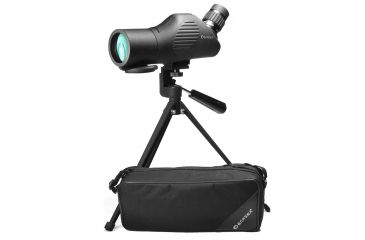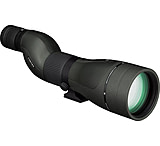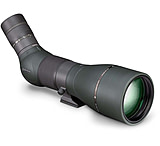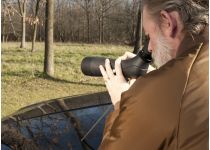
Spotting scopes are commonly used to score targets at varying distances, but many shooters aren't sure of what is required in terms of magnification, objective size and, especially, optical quality when shooting at a given distance. How good a spotting scope is needed for 100 yard scoring as opposed to 400 yard scoring?![]()
Before getting down to cases, there is the matter of observing conditions to consider. Air turbulence, heat mirage, dust, humidity, haze and other atmospheric conditions all affect image quality when using a shooting spotting scope and these conditions can change by the hour. There is no escape from this. Even a premium grade spotting scope for targeting shooting can be rendered useless under severe conditions of heat waves and mirage and adding more magnification or distance to the target just makes the problem worse. Before passing judgment on any spotting scope, then, it is important to make test under a variety of conditions. A lot of scopes get blamed for poor performance when, in fact, the atmosphere is the culprit.
Assuming favorable conditions, though, we can move into features and quality issues.
Basic Features
As for features, most shooters want an eyepiece with plenty of eye relief, because they are typically not in a position to get their eye close to the eyepiece when shooting. 15mm is a minimum, here and most shooters are happy with a bit more. For the same reason, many shooters like angled bodied spotting scopes and rotating tripod collars, which allow the scope body and hence, the eyepiece, to be rotated to various positions.
Spotting Scope Yardage
Up to 100 Yards
Out to 100 yards, you don't need a target shooting spotting scope with a large objective, a lot of magnification or premium grade optics to get the job done. 18-36x or so will be plenty of magnification to see bullet holes at 100 yards and even a good 50mm objective will have enough resolution to see 22 bullet holes. A 60mm, objective, though, will give you more margin for error and still be portable as well as affordable. If you are scoring targets for air rifle or rim fire competition, be sure to check "close focus" or "minimum focus" under a spotting scope's specs. Not all target shooting scopes will focus as close as 33 feet (10m).
Over 100 Yards
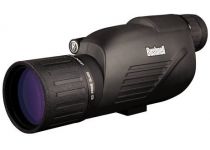
Beyond 100 yards, we need to be more selective and here is where optical quality starts to become an issue. Why? As distance increases, we need more magnification to see the target. Obvious. What many shooters don't realize, however, is that as magnification goes up in a spotting scope, the optical demands on the optical system also go up and rather quickly, at that. Most scopes look good at 20x, but as you zoom up in magnification, image quality goes down in all but the very finest (and most expensive) spotting scopes. If you want an image as sharp at 60x as it is at 20x, you will need to pay the price. Otherwise, expect some drop-off in image quality as magnification goes up and expect this drop-off to occur more quickly on a cheap scope. Just because a cheap scope offers the same magnification as the expensive scope doesn't count for much. A blurred image at 30x is only going to get worse at 60x.
Unfortunately, you can't put a number on optical quality. Two scopes can have identical specs, but be totally different in the distances they can handle. It's optical quality at work - how precisely the lenses are ground, the type and quality of the glass used, the lens coatings and the alignment of the optical system to name just a few. It's not just the objective, either. It's the prism system, the way the inside of the scope is baffled to reduce stray light and it is also the eyepiece - the most overlooked part of the system. Premium grade eyepieces cost a small fortune and for good reason. A spotting scope is only as good as its weakest link.
The good news is that most 60mm objective spotting scopes to 80mm objective spotting scopes at $200 and up have enough optical quality to handle 200 yard scoring, assuming reasonable observing conditions. This distance is as much as most shooters need for sighting in and/or to check load performance.
300 Yards
Going to 300 yards, though, ups the ante in a big way. It's much more demanding than the extra 100 yards would indicate. Optical quality becomes the single determining factor at this range. Forget cheap scopes with big objectives lenses. Cheap jumbo objectives are still cheap objectives and no amount of advertising will turn them in quality lenses. For 300 yard work, I recommend larger 80mm objectives to better handle the magnifications needed. You can choose between a scope excellent quality in standard glass version or of reasonable quality in ED glass. You must, however, make sure to have an eyepiece that is up to speed for a quality objective. Just adding an ED objective to a cheaper scope is a waste of money if you keep the cheap eyepiece behind it. In general, I usually recommend the Bushnell (formerly Bausch&Lomb) 20-60x80, as a minimum for 300 yard scoring. This is in the neighborhood of $650.
400 Yards
Going to 400 yards puts severe demands on the optical system and you jump right into the premium grade scopes to get the job done. No shortcuts, here. Pay the money or get up from the bench and start walking. At this distance you will also do an ever changing battle with observing conditions. You may see the bull for a few seconds, then lose it for a few seconds as the atmosphere shifts gears. After all, you are looking through a lot more air, now. Prices start at $1000 for this kind of quality. I like the Brunton Eterna 80mm ED and the Pentax PF80ED, as a minimum, but going the extra mile to these next five - the Kowa Fluorite, Nikon Fieldscope 82mm ED, Zeiss 85mm or Swarovski 80HD is money well spent and will get the job done under more marginal conditions.
500 Yards and Beyond
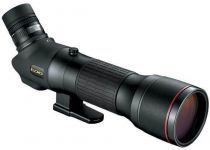
Going to 500 yards and beyond is the exclusive province of those last five (the Big Five, in my book) and, as any experienced shooter will tell you, premium spotting scopes are used at these distances more to judge atmospheric quality and air currents than for scoring. A spotting scope, even a premium one, needs help for scoring at these extreme distances, usually in the form of a spotter or tagger at the target. When someone actually invents a spotting scope that can be used for scoring bullet holes at 1000 yards, without the help of a spotter, I will be the first to buy one. Until then, such a spotting scope is a fantasy.
